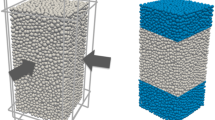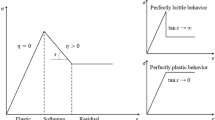Abstract
Multiple-step loading triaxial compression test (ML-TCT) method is a useful tool to evaluate strength parameters of rock samples using a single specimen applying several loading/unloading. However, because of accumulated damages in the specimen with repeated cycles of axial loading/unloading, the shear strength is prone to be underestimated. A multiple-step loading damage (MLD) model was proposed to simulate ML-TCT results. Two series of ML-TCTs were carried out on a sedimentary soft rock of mudstone. The first series was to determine the geotechnical parameters to describe the MLD model, and the second series was to verify the model. The results demonstrated that the proposed MLD model was powerful to simulate ML-TCTs on the mudstone and modify the results of carried out tests to generate more reliable results. Moreover, a generalized MLD model was constructed. This model allows prediction of peak deviator stresses and the relevant excess pore water pressures in a ML-TCT for rocks having different strength which generally are affected by the previous loading history. The generalized MLD model indicates that the margin between shear strength parameters obtained by single-step loading triaxial compression tests and ML-TCTs, increases with an increase in the rock strength. Moreover, upper bound values for effective cohesion, c′, and lower bound values for, effective friction angle, ϕ′, was obtained in a ML-TCT with increasing effective confining pressure, σ′c. Whereas, upper bound values for ϕ′ and lower bound values for c′ predicted in a ML-TCT with decreasing σ′c. It was concluded that, ML-TCT increasing σ′c is preferable to ML-TCT decreasing σ′c.

















Similar content being viewed by others
Abbreviations
- ρt :
-
Wet density
- σa :
-
Axial stress
- εa :
-
Axial strain
- σ′c :
-
Horizontal (cell) effective stress
- ϕ′:
-
Effective friction angle
- c′:
-
Effective cohesion
- q u :
-
Uniaxial compressive strength
- ε Pa :
-
Cumulative plastic axial strain
- Δε Pa :
-
Increment of plastic axial strain
- q f, SL :
-
Peak deviator stress in single-step loading test
- q f, ML :
-
Peak deviator stress in multiple-step loading test
- Δuf, SL :
-
Excess pore water pressure in single-step loading test
- q f, ML :
-
Excess pore water pressure in multiple-step loading test
- q f, ML/q f, SL :
-
Shear strength ratio
- Δuf, ML/Δuf, SL :
-
Excess pore water pressure ratio
- V p :
-
Primary wave velocity
- Vs:
-
Secondary wave velocity
- ML-TCT:
-
Multiple-step loading triaxial compression test
- SL-TCT:
-
Single-step loading triaxial compression test
- MLD:
-
Multiple-step loading damage
References
Akai K, Ohnishi Y, Lee D (1981) Improved multiple-stage triaxial test method for soft rock. In: Proceedings of the international symposium on weak rock, vol 1, pp 75–80
Anderson WF (1974) The use of multi-stage triaxial tests to find the undrained strength parameters of stony boulder clay. In: Proceedings of Institute of Civil Engineering, Pt. 2, vol 57. Thomas Telford Ltd., London, pp 367–373
Bro A (1997) Analysis of multistage triaxial test results for a strain-hardening rock. Int J Rock Mech Min Sci 34:143–145
Crawford A, Wylie DA (1987) modified multiple failure state triaxial testing method. In: Proceedings of 28th US symposium on rock mechanics, pp 40–133
De Beer EE (1950) The cell test. Geotechnique 2(2):162–172
Goodman RE (1976) Methods of geological engineering in discontinuous rocks. West Publishing Company, New York, pp 158–180
International Society of Rock Mechanics (ISRM) (1981) Rock characterization, testing and monitoring; ISRM suggested method. Pergamon Press, Oxford
JGS (2001) Triaxial compression test on soft rocks. Japanese Geotechnical Standard, Tokyo, pp 25–33
Kenney TC, Watson GH (1961) Multiple-stage triaxial tests for determination c′ and ϕ′ of saturated soils. In: Proceedings of 5th international conference on soil mechanics and foundation engineering, vol 1. pp 191–195
Kim MM, Ko HY (1979) Multistage triaxial testing of rocks. Geotech Test J 2:98–105
Kovari K, Tisa A (1975) Multiple failure state and strain controlled triaxial tests. Rock Mech 7:17–33
Kovari K, Tisa A, Einstein HH, Franklin JA (1983) Suggested methods for determining the strength of rock material in triaxial compression: revised version. Int J Rock Mech Min Sci 20(6):283–290
Pagoulatos A (2004) Evaluation of multistage triaxial testing on Berea sandstone. M.Sc Thesis, The University of Oklahama
Schoenemann MR, Pyles MR(1988) Stress path considerations in multistage triaxial testing. In: Donaghe RT, Chancy RC, Silver ML (eds) Advanced triaxial testing of soils and rocks, ASTM STP 977, pp 732–739
Sorenzo M (1988) Results and interpretation of multistage triaxial compression tests. In: Donaghe RT, Chancy RC, Silver ML (eds) Advanced triaxial testing of soils and rocks, ASTM STP 977. American Society for Testing and Materials, Philadelphia, pp 353–362
Tani K (2007) Proposal of multiple-step loading damage model to simulate multiple-step loading triaxial compression test. In: Proceedings of 1st SriLankan Society international conference on soil and rock engineering. 6p
Author information
Authors and Affiliations
Corresponding author
Rights and permissions
About this article
Cite this article
Taheri, A., Tani, K. Developing a Damage Model to Simulate Multiple-Step Loading Triaxial Compression Tests in Rocks. Geotech Geol Eng 31, 541–556 (2013). https://doi.org/10.1007/s10706-012-9607-1
Received:
Accepted:
Published:
Issue Date:
DOI: https://doi.org/10.1007/s10706-012-9607-1




